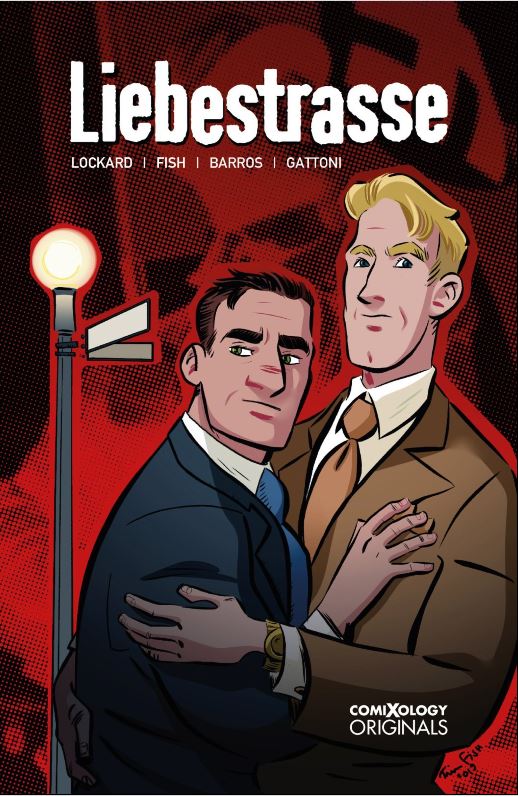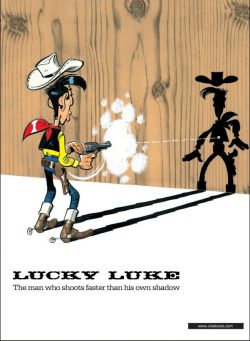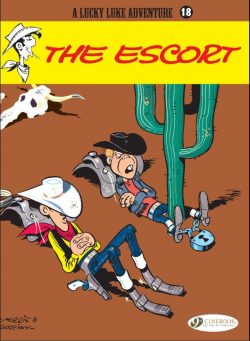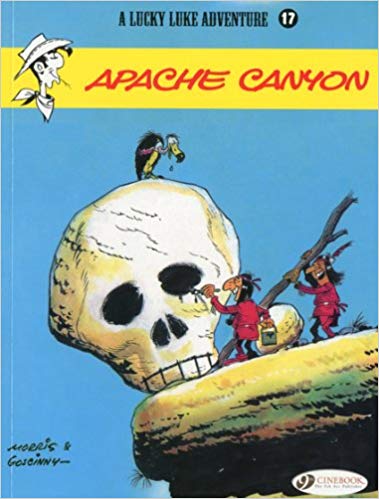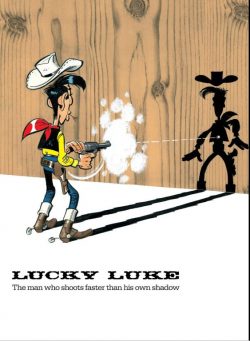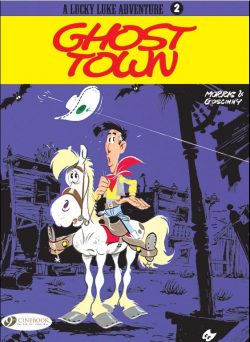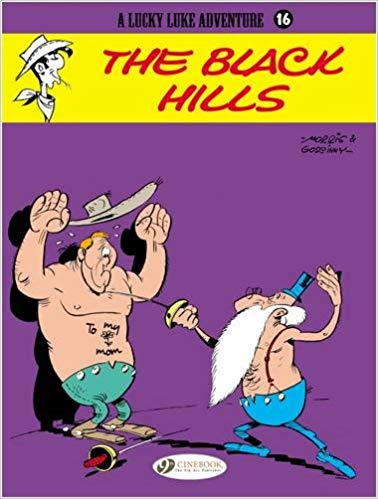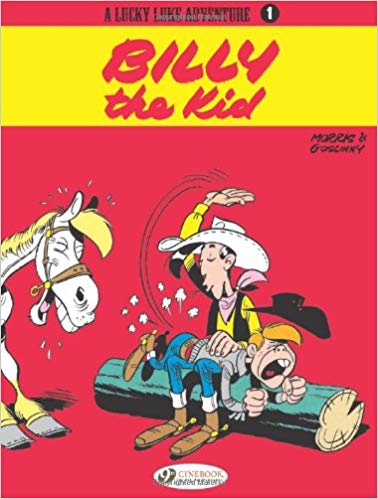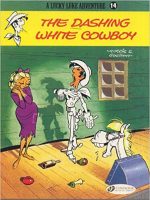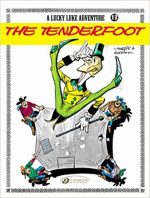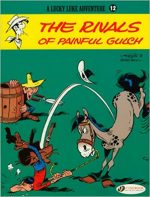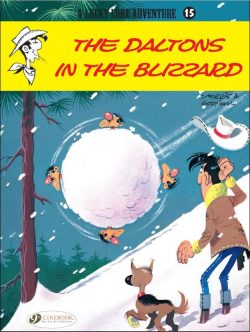
By Morris & Goscinny, translated by Luke Spear (Cinebook)
ISBN: 978-1-905460-76-2
Doughty cowboy Lucky Luke is a rangy, good-natured do-gooder able to “draw faster than his own shadowâ€. He amiably roams the fabulously mythic Old West, enjoying light-hearted adventures on his rather sarcastic know-it-all wonder-horse Jolly Jumper. The taciturn nomad constantly interacts with a host of historical and legendary figures as well as even odder folk…
His unceasing exploits over 7 decades years have made him one of the best-selling comic characters in Europe – if not the world – generating in excess of 83 individual albums, sales totalling in excess of 300 million in 30 languages… so far…
That renown has generated the usual mountain of spin-off toys, computer games, animated cartoons and a plethora of TV shows and live-action movies.
First seen in the seasonal Annual L’Almanach Spirou 1947 (of weekly Le Journal de Spirou), Lucky was created in 1946 by Belgian animator, illustrator and cartoonist Maurice de Bévère (“Morrisâ€), before ambling into his first weekly adventure ‘Arizona 1880’ on December 7th 1946.
Working solo until 1955, Morris produced nine albums of affectionate sagebrush spoofery before teaming with old pal and fellow trans-American tourist Rene Goscinny, who became regular wordsmith as Luke attained the dizzying, legendary, heights starting with ‘Des rails sur la Prairie’ (Rails on the Prairie), which began serialisation in Spirou on August 25th 1955.
In 1967, the six-gun straight-shooter switched sides, joining Goscinny’s own magazine Pilote with ‘La Diligence’ (The Stagecoach). Goscinny co-created 45 albums with Morris before his untimely death, from whence Morris soldiered on both singly and with fresh collaborators.
Morris died in 2001, having drawn fully 70 adventures, plus numerous spin-off sagas crafted with Achdé, Laurent Gerra, Benacquista & Pennac, Xavier Fauche, Jean Léturgie, Jacques Pessis and others, all taking their own shot at the venerable vigilante…
Lucky Luke has previous in this country too, having first pseudonymously amused and enthralled British readers during the late 1950s, syndicated to weekly anthology Film Fun. He later rode back into comics-town in 1967 for comedy weekly Giggle, where he used the nom de plume Buck Bingo.
In all these venues – as well as many attempts to follow the English-language album successes of Tintin and Asterix – Luke laconically puffed a trademark cigarette which hung insouciantly and almost permanently from his lip. However, in 1983 Morris – amidst pained howls and muted mutterings of “political correctness gone mad†– deftly substituted a piece of straw for the much-travelled dog-end, thereby garnering for himself an official tip of the hat from the World Health Organization.
The most successful attempt to bring Lucky Luke to our shores and shelves comes from Cinebook (who rightly restored the foul weed to his lips on the interior pages, if not the covers…), and it’s clearly no big deal for today’s readership as we’re at 69 translated books and still going strong.
Le Dalton dans le blizzard was Morris & Goscinny’s 13th collaboration, originally serialised in 1963 (and becoming the hero’s 22nd album release in 1971): a dogged tale of determination and tomfoolery brimming with daft riffs on the classic plot of a manhunt in arctic climes.
The drama begins when a birthday party at a Texas penitentiary is brought to an abrupt halt when the guards realise the appalling Dalton Brothers have once again escaped. By the time a desperate telegram reaches Luke at Awful Creek, his intolerable arch-enemies and owlhoot miscreants Averell, Jack, William and devious, slyly psychotic, overly-bossy diminutive brother Joe have shucked their shackles and embarked on a strange switch in modus operandi…
Instead of indulging in another rampage of robbery and riot, the quartet have assumed fake identities and steadily, inconspicuously, made their way north, into Canada and beyond Lucky’s notice and jurisdiction. Or so they think…
A little bit fed up with continually having to recapture the bandit brothers, Luke has grudgingly accepted the help of prison guard dog Rin Tin Can, a pathetic pooch who has past experience with the Daltons.
The mutt is vain, lazy, friendly and exceedingly dim and utterly loyal to absolutely everybody so Lucky uses him as a compass heading exactly opposite to the direction the dog wants to go…
After his introduction in 1962’s Sur la piste des Dalton, (On the Daltons’ Trail) Rantanplan – “dumbest dog in the West†and a wicked parody of cinema canine Rin-Tin-Tin – became an irregular feature in many adventures before eventually landing his own spin-off series title.
Before long the starving fugitives have crossed the border – albeit mere hours ahead of their pursuer – and met their first northern lawman. The elderly Mountie seems harmless and has no beef with them as they haven’t committed any crimes… yet.
Corporal Pendergast is quite a stickler for rules though, and the boys have reason to amend their first impressions after he stops a brutal bar fight and has the perpetrators surrender themselves to custody on their own recognizance. Canadians are tough and fierce but incredibly polite and law-abiding…
Emboldened, they rob a saloon and then the chase is on over icy wastes with Luke and the Corporal chasing hard and with dog determinedly trying to drag them in the wrong direction…
After a string of hold-ups, our heroes finally arrest them but Pendergast has never met felons who refused to stay locked up and, after another bold breakout, the chase resumes. Heading ever northwards, the Daltons hide out as lumberjacks, betray generous First Nation Indians who save them from a waterfall and take over the most remote outpost of gold rush miners in Canada, but the lawmen just won’t quit coming.
Eventually, with nothing but arctic ice and deadly snowstorms facing them, the fugitives have no choice but to turn and fight or be eaten by wolves…
Although perfectly packed with the mandatory slapstick antics and appalling puns, The Daltons in the Blizzard is primarily an action romp with buckets of engaging spectacle and sly pokes and national stereotypes, replete with dirty double-dealing and barrel-loads of hilarious buffoonery.
This is another perfect all-ages confection by unparalleled comics masters, affording an enticing glimpse into a unique genre for today’s readers who might well have missed the romantic allure of an all-pervasive Wild West that never was…
© Dargaud Editeur Paris 1971 by Goscinny & Morris. © Lucky Comics. English translation © 2008 Cinebook Ltd.
